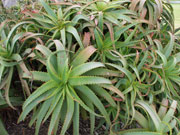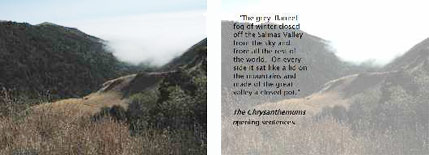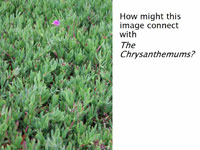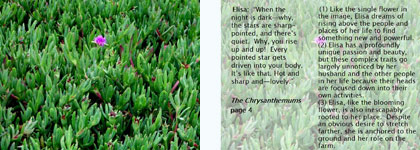Teacher Resources
A Knot of Their Own Invention:
Creating Visual Metaphors of Place to Illuminate Steinbeck Texts
by Paul Grubbs, Fox Valley Lutheran High School, Appleton, Wisconsin, 2007
1. Details
Title of text
My lesson plan was developed in connection with John Steinbeck’s The Grapes of Wrath, but could be easily adapted to work alongside the author’s other works (or the work of another author with a parallel emphasis on place.)
Grade Level
9-12
Purpose/Objective
 During morning walks at the 2007 NEH Institute, the reptilian swarms of plants along the cliff’s edge on Ocean View Boulevard in Pacific Grove consistently grabbed my attention. These plants brought to mind the aggressive mob in Steinbeck’s short story The Raid or the faceless mass of predatory corporate growers in his novel The Grapes of Wrath. Thinking about this connection with an element of nature helped me reconsider the power and imagery of Steinbeck’s writing. I studied my photographs of the plants and felt that creating these images helped me find a more tactile, memorable understanding of Steinbeck’s warnings about the power of a mob’s blind, cold-blooded inhumanity. My students often have to be prodded forward in their hunt for symbols, but creating their own visual metaphors in connection with the text could amplify their understanding of the work and increase their confidence about decoding symbolic language in various media. During morning walks at the 2007 NEH Institute, the reptilian swarms of plants along the cliff’s edge on Ocean View Boulevard in Pacific Grove consistently grabbed my attention. These plants brought to mind the aggressive mob in Steinbeck’s short story The Raid or the faceless mass of predatory corporate growers in his novel The Grapes of Wrath. Thinking about this connection with an element of nature helped me reconsider the power and imagery of Steinbeck’s writing. I studied my photographs of the plants and felt that creating these images helped me find a more tactile, memorable understanding of Steinbeck’s warnings about the power of a mob’s blind, cold-blooded inhumanity. My students often have to be prodded forward in their hunt for symbols, but creating their own visual metaphors in connection with the text could amplify their understanding of the work and increase their confidence about decoding symbolic language in various media.
The purpose of my lesson is to challenge students to create images, visual metaphors, from their local environment that illustrate their understanding of critical ideas from the text. Translating character types, emotions, conflicts, and patterns into images requires complex comprehension and an ability to shape judgments into pictures that can be used as teaching tools for the rest of the class. Searching for the images in their own surroundings will underline Steinbeck’s “rapt attention to the external world” (Shillinglaw 6) for students and transplant that focus to the reader’s personal spaces. The collected set of images will serve as a ready resource for classroom presentations or a display could be a fitting concluding activity for a class’s experience with the author.
2. Overview
After introducing Steinbeck’s emphasis on visual metaphors and symbolism through Matthew Spangler’s adaptation of Steinbeck’s “The Chrysanthemums,” Students will survey their homes, schools, and local environment to create a photograph of nature and/or place that can serve as a visual metaphor for an idea, character, motif, or other important element of The Grapes of Wrath. Students should identify a passage from the text to present alongside their image, along with a brief explanation of the connections they intend to raise. These pictures should be metaphors, rather than literal illustrations (for example, a angry classmate wearing tattered clothes would be an inappropriate response to Muley Graves, while a prickly cactus plant in otherwise barren ground might provide a useful picture of the same character.) These images and text will be visual evidence of a student’s first step in achieving Steinbeck’s goal of reader participation, engaging them in helping others understand the author’s message in a personal context.
3. Procedures
“John Steinbeck was ready to unravel his intertwined heritage of place, history, and people—and to retie it with a knot of his own invention” (Shillinglaw 3). The goal of this project is to provide an opportunity for students to create their own work of photographic art that uses the lens of place to extend their understanding of Steinbeck’s work.
Day 1
NOTE: Days are divided according to a 43-minute period schedule.
Materials: Download a copy of Professor Matthew Spangler’s chamber theater adaptation of “The Chrysanthemums” (PDF)
- Identify “The Chrysanthemums” as the most widely anthologized piece from Steinbeck’s sole collection of short stories, The Long Valley. This volume was written during the Golden Age of the short story (1920-1950), when top-shelf authors like F. Scott Fitzgerald commanded $4,000 per story (about $45,000 in contemporary terms). Steinbeck wrote and sold fifteen short stories during the year this collection was compiled. Steinbeck’s passion for the genre vanished after his first successful novel, Tortilla Flat (Background information taken from Fink lecture outline 1-2).
- Distribute copies of Professor Matthew Spangler’s chamber theater adaptation of “The Chrysanthemums.” Explain the basics of chamber theater: Scripts use as much of the original text as possible, with occasional original lines to bridge understanding gaps. Performances employ a minimum of props and staging, and actors often play multiple roles or take on lines of narration outside their character’s speech.
- Take volunteers for Reader’s Theater performance of the piece.
- Re-read the opening paragraphs setting scene and provide 2-3 minutes for students to identify a setting-oriented detail and pose a question regarding their identified detail.
- Carry out dialogic discussion (driven by student questions and interaction) of setting details, prompted by the question, “What got your attention about Steinbeck’s description of place and how might this image fit the author’s purpose with the story?” Students might prepare a rough sketch of details identified by peers and list class ideas as the teacher does the same on the board.
- Provide closure as time expires by explaining that tomorrow the class will continue to develop our understanding of the importance of place by discussing the creation of images.
Day 2
Materials: Example visual metaphors on powerpoint or other means of display
- Review from yesterday – what setting details from Matt Spangler’s adaptation of “The Chrysanthemums” stuck with students a day after their discussion?
- Explain that the class project will extend the study of place in literature with student-created photography. Discuss the difference between illustrating a text (taking pictures that literally re-create the words of the text) and preparing visual metaphors (images that use a different physical object to highlight something about a character, idea, motif, or theme.)
Example of illustration: (Printed text: “The grey flannel fog of winter closed off the Salinas Valley from the sky and from all the rest of the world. On every side it sat like a lid on the mountains and made of the great valley a closed pot” “The Chrysanthemums,” opening sentences)
Printed text:

This image, taken during a driving tour through the Big Sur region on July 14, 2007, merely illustrates the setting for “The Chrysanthemums” – it literally reproduces the description from the text visually. While illustrating a text could also be a valuable learning experience, it is not the goal of this project.
Display the following image of a single blooming flower, taken along Ocean View Avenue in Pacific Grove on July 10, 2007, and challenge students to copy the question and spend 3-4 minutes freewriting about their ideas. (Printed text: How might this image connect with “The Chrysanthemums?”)

When time expires, invite students to exchange free-writes with a partner and re-phrase the most provocative suggestion as a new sentence. Then use volunteers to build a list of possibilities on the board, explaining the way each overlays the original text with a new level of symbolism and metaphor.
Explain that the next element of a valuable visual metaphor will be finding a textual quote (in this case from the script) to evidence the implied suggestion. Challenge students to spend five-seven minutes digging through “The Chrysanthemums” script to identify text that would serve as appropriate evidence for their understanding of the connection between the story/characters/theme and the provided image. An example possibility for the blooming flower might include Elisa’s dialogue from script’s fourth page: “When the night is dark—why, the stars are sharp-pointed, and there’s quiet. Why, you rise up and up! Every pointed star gets driven into your body. It’s like that. Hot and sharp and—lovely.”
The teacher could choose to ask students to share their selected linked passages now, but it might be more productive to wait until the next phase of the discussion, when students will be asked to write three sentences explaining the link they see between the blooming flower image and their selected quotation from the script.
Instruct students to study their image and textual passage and write three sentences explaining the link their mind is making between the two pieces of art. An example possibility for the quoted Elisa dialogue above: “(1) Like the single flower in the image, Elisa dreams of rising above the people and places of her life to find something new and powerful. (2) Elisa has a profoundly unique passion and beauty, but these complex traits go largely unnoticed by her husband and the other people in her life because their heads are focused down into their own activities. (3) Elisa, like the blooming flower, is also inescapably rooted to her place. Despite an obvious desire to stretch farther, she is anchored to the ground and her role on the farm.”
Ask students to share their quote and three-sentence explanation with a partner. Then take volunteers to share their suggestions with the entire class.
Explain that each student’s work on the project will conclude with a brief presentation that brings together an image, textual quotation, and student explanation on a single power point slide for class discussion. The following example can be offered or distributed as a guide:

The second, text-heavy slide would not necessarily need to be part of the final class presentation, but could instead serve as a rough draft of the student’s presentation script and a gradeable text for the instructor. Student presentations would be guided by the image alone on the screen and perhaps a set of note cards. See grading rubric for scoring possibilities.
Take any remaining questions. Announce a proposed due date when whole-class or small group presentations will begin.
Download Grading Rubric (PDF)
Works Cited
- The Chrysanthemums. By John Steinbeck. Adapted for chamber theater by Matthew Spangler. NEH Steinbeck Institute, Pacific Grove. 6 July 2007.
- Fink, Chris. “Steinbeck’s Short Stories and The Long Valley.” NEH Institute lecture. Pacific Grove, CA: 9 Jul. 2007.
- Shillinglaw, Susan. A Journey Into Steinbeck’s California. Berkeley: Roaring Forties Press, 2006.
|

